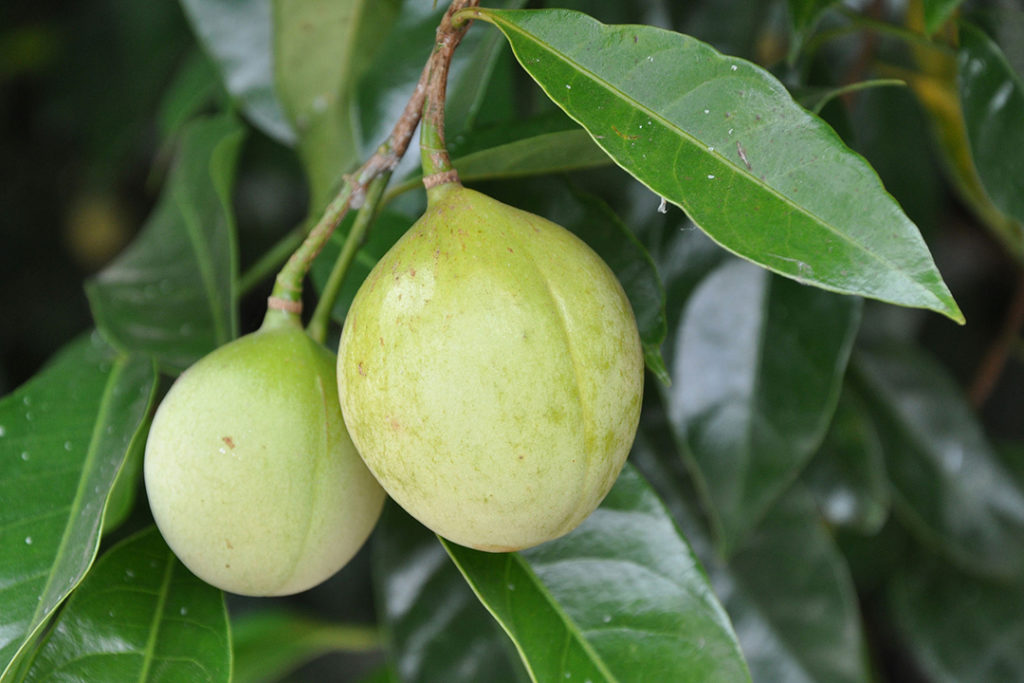
Grenada
Nutmeg
Myristica fragrans

General Description / Cultural Significance
Nutmeg, Myristica fragrans, is a scent that represents Grenada, a small country known as “The Isle of Spice.” Grenada is responsible for producing about 1/3 of the world’s supply of nutmegs, second only to Indonesia. Nutmeg’s complex spicy sweet smell with earthy undertones has been well-known to generations of Grenadians, and its cultural strength and symbolic power is reflected in the fact that it is the only country with nutmeg on its flag. Myristica fragrans is an evergreen tree that grows bell-shaped, pale yellow flowers and fruits with a fleshy husk, similar to apricots. When the husk is cracked open, one finds a hard brown seed, which is the source of nutmeg. Contrary to popular belief, it is a seed and not a nut. Mace is the dried red membrane covering of the shell of the seed, also a valuable spice, and is antibacterial and antifungal.
The seeds of nutmeg are always freshly ground for maximum aromatic and warm taste. They are used on a wide range of sweet dishes like cakes, puddings, and jams, but also on savory foods or in warm milk. Closely guarded family recipes involving nutmeg are emotionally significant to Grenadians. The nutmeg trees are grown by the island’s seven thousand growers who each farm on five acres or less. There is old traditional knowledge and much superstition surrounding nutmeg. Rural farmers and families often wear a nut on a string around their neck or place nuts in their mouths, taking in its pungent flavor, using it to ward off medical problems and relieve aches and pains. Additionally, new uses are always being found for nutmeg.
Nutmeg is rich in essential oils that are stimulant, aphrodisiac, digestive aids, and reduce anxiety. It is anti-inflammatory and used for gum disease. The essential oil is rubbed on the body to ease joint pain. It is a hallucinogen when taken in the right amounts, and a narcotic chosen to achieve a cheap and quick high, but it can be dangerous and deadly at high doses. Eating just two nutmeg seeds can cause death.
Climate Change/Conservation Status
Climate change is currently a huge threat to the country of Grenada. They are at high risk for coastal flooding and drought, as well as risk for coastal storms. These catastrophes are threatening both infrastructure and livelihoods. Between the years 2002 and 2004, two massive hurricanes destroyed over half a million nutmeg trees. The country still hasn’t been able to recover enough to produce the amounts of nutmeg that it did prior to the natural catastrophes. Due to the tree’s shallow roots, it is unfortunately very easily uprooted by strong winds despite that it is drought resistant and protects the soil it grows from. Windbreaks are important to farmers as far as developing sustainable ways of growing nutmeg in spite of the threat of extreme weather. Another process by which male trees are converted to female trees has also been helping to boost nutmeg production. It is to be determined to what extent farmers can find methods to combat climate challenges, but it seems that these farming innovations mean nutmeg yields from Grenada are steadily increasing.
Alternate Names
Black gold
Fragrant nutmeg
Mace
True nutmeg
Sources
Ewig-Chow, D., 2020. Nutmeg: Grenada’s ‘Black Gold’ is on the Cusp of Resurgence. Forbes. [website]
Shop D’Caribbean, n.d. Ground Nutmeg. Shop D’Caribbean. [website]
Mission of Grenada to the United Nations, Research for World Sensorium. This statement can be found on the World Sensorium original website.
Mydans, S., 1984. Nutmeg Diplomacy in Grenada: The Aftermath of Invasion. The New York Times. [website]
Fern, K., n.d. Myristica Fragrans. Useful Tropical Plants Database. [website]
Katzer, G., 2004. Nutmeg and Mace (Myristica fragrans Houtt.) Gernot Katzer’s Spice Pages. [website]

